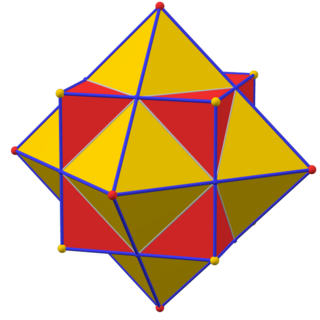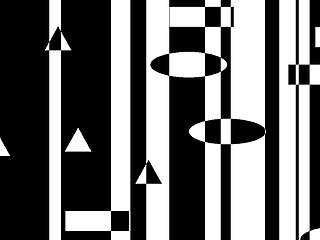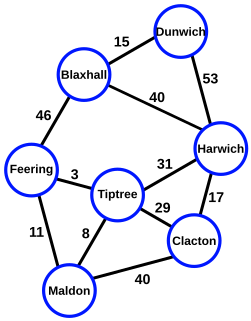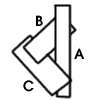
In geometry, any polyhedron is associated with a second dual figure, where the vertices of one correspond to the faces of the other and the edges between pairs of vertices of one correspond to the edges between pairs of faces of the other. Such dual figures remain combinatorial or abstract polyhedra, but not all are also geometric polyhedra. Starting with any given polyhedron, the dual of its dual is the original polyhedron.

In geometry, a polyhedron is a solid in three dimensions with flat polygonal faces, straight edges and sharp corners or vertices. The word polyhedron comes from the Classical Greek πολύεδρον, as poly- + -hedron.
In elementary geometry, a polygon is a plane figure that is described by a finite number of straight line segments connected to form a closed polygonal chain or polygonal circuit. The solid plane region, the bounding circuit, or the two together, may be called a polygon.
In graph theory, a planar graph is a graph that can be embedded in the plane, i.e., it can be drawn on the plane in such a way that its edges intersect only at their endpoints. In other words, it can be drawn in such a way that no edges cross each other. Such a drawing is called a plane graph or planar embedding of the graph. A plane graph can be defined as a planar graph with a mapping from every node to a point on a plane, and from every edge to a plane curve on that plane, such that the extreme points of each curve are the points mapped from its end nodes, and all curves are disjoint except on their extreme points.

The painter's algorithm, also known as a priority fill, is one of the simplest solutions to the visibility problem in 3D computer graphics. When projecting a 3D scene onto a 2D plane, it is necessary at some point to decide which polygons are visible, and which are hidden.

Scanline rendering is an algorithm for visible surface determination, in 3D computer graphics, that works on a row-by-row basis rather than a polygon-by-polygon or pixel-by-pixel basis. All of the polygons to be rendered are first sorted by the top y coordinate at which they first appear, then each row or scan line of the image is computed using the intersection of a scanline with the polygons on the front of the sorted list, while the sorted list is updated to discard no-longer-visible polygons as the active scan line is advanced down the picture.

Texture mapping is a method for defining high frequency detail, surface texture, or color information on a computer-generated graphic or 3D model. The original technique was pioneered by Edwin Catmull in 1974.

In computer graphics, z-buffering, also known as depth buffering, is the management of image depth coordinates in 3D graphics, usually done in hardware, sometimes in software. It is one solution to the visibility problem, which is the problem of deciding which elements of a rendered scene are visible, and which are hidden. Z-buffering was first described in 1974 by Wolfgang Straßer in Chapter 6 of his PhD thesis. The painter's algorithm is another common solution which, though less efficient, can also handle non-opaque scene elements. The z-buffer uses the Image space method for hidden surface detection. A z-buffer can refer to a data structure or to the method used to perform operations on that structure.
Alpha–beta pruning is a search algorithm that seeks to decrease the number of nodes that are evaluated by the minimax algorithm in its search tree. It is an adversarial search algorithm used commonly for machine playing of two-player games. It stops evaluating a move when at least one possibility has been found that proves the move to be worse than a previously examined move. Such moves need not be evaluated further. When applied to a standard minimax tree, it returns the same move as minimax would, but prunes away branches that cannot possibly influence the final decision.
In 3D computer graphics, shown-surface determination is the process used to determine which surfaces and parts of surfaces are not visible from a certain viewpoint. A hidden-surface determination algorithm is a solution to the visibility problem, which was one of the first major problems in the field of 3D computer graphics. The process of hidden-surface determination is sometimes called hiding, and such an algorithm is sometimes called a hider. The analogue for line rendering is hidden-line removal. Hidden-surface determination is necessary to render an image correctly, so that one may not view features hidden behind the model itself, allowing only the naturally viewable portion of the graphic to be visible.
Martin Edward Newell is a British-born computer scientist specializing in computer graphics who is perhaps best known as the creator of the Utah teapot computer model.
In computer science, a topological sort or topological ordering of a directed graph is a linear ordering of its vertices such that for every directed edge uv from vertex u to vertex v, u comes before v in the ordering. For instance, the vertices of the graph may represent tasks to be performed, and the edges may represent constraints that one task must be performed before another; in this application, a topological ordering is just a valid sequence for the tasks. A topological ordering is possible if and only if the graph has no directed cycles, that is, if it is a directed acyclic graph (DAG). Any DAG has at least one topological ordering, and algorithms are known for constructing a topological ordering of any DAG in linear time.

In geometry, a vertex figure, broadly speaking, is the figure exposed when a corner of a polyhedron or polytope is sliced off.
The Weiler–Atherton is a polygon-clipping algorithm. It is used in areas like computer graphics and games development where clipping of polygons is needed. It allows clipping of a subject or candidate polygon by an arbitrarily shaped clipping polygon/area/region.
Clipping, in the context of computer graphics, is a method to selectively enable or disable rendering operations within a defined region of interest. Mathematically, clipping can be described using the terminology of constructive geometry. A rendering algorithm only draws pixels in the intersection between the clip region and the scene model. Lines and surfaces outside the view volume are removed.

A stencil buffer is an extra data buffer, in addition to the color buffer and Z-buffer, found on modern graphics hardware. The buffer is per pixel, and works on integer values, usually with a depth of one byte per pixel. The Z-buffer and stencil buffer often share the same area in the RAM of the graphics hardware.

In graph algorithms, the widest path problem is the problem of finding a path between two designated vertices in a weighted graph, maximizing the weight of the minimum-weight edge in the path. The widest path problem is also known as the bottleneck shortest path problem or the maximum capacity path problem. It is possible to adapt most shortest path algorithms to compute widest paths, by modifying them to use the bottleneck distance instead of path length. However, in many cases even faster algorithms are possible.
In computer graphics, A-buffer, also known as anti-aliased, area-averaged or accumulation buffer, is a general hidden surface mechanism suited to medium scale virtual memory computers. It resolves visibility among an arbitrary collection of opaque, transparent, and intersecting objects. Using an easy to compute Fourier window, it increases the effective image resolution many times over the Z-buffer, with a moderate increase in cost.
This is a glossary of terms relating to computer graphics.









